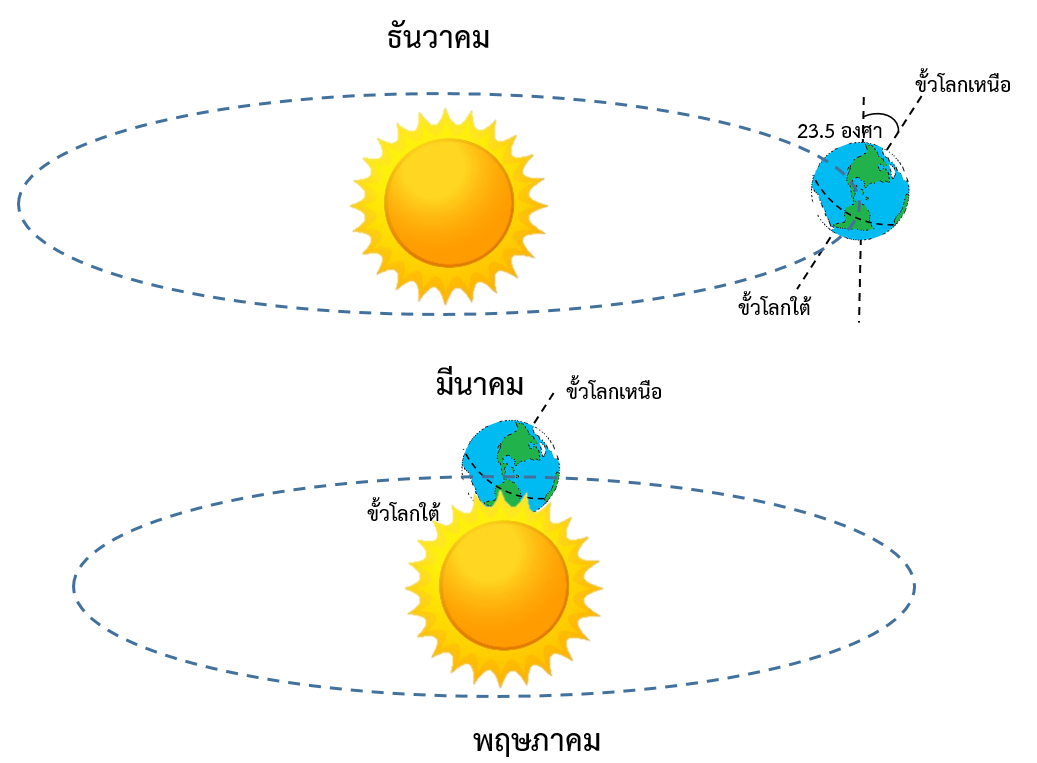มโนทัศน์ของนักเรียนระดับชั้นมัธยมศึกษาปีที่ 3 เกี่ยวกับการเกิดฤดู
Main Article Content
บทคัดย่อ
งานวิจัยนี้เป็นการสำรวจมโนทัศน์ของนักเรียนระดับชั้นมัธยมศึกษาปีที่ 3 จำนวน 103 คน ในโรงเรียนมัธยมขนาดใหญ่แห่งหนึ่งในจังหวัดเชียงใหม่ ที่เรียนวิชาวิทยาศาสตร์ ในภาคเรียนที่ 2 ประจำปีการศึกษา 2559 ในหัวข้อที่เกี่ยวข้องกับการเกิดฤดู นักเรียนทั้งหมดจะได้รับการตรวจสอบมโนทัศน์ด้วยคำถามปลายเปิด 1 คำถามว่า ฤดู เกิดขึ้นได้อย่างไร พร้อมทั้งให้อธิบายเพื่อสนับสนุนคำตอบให้ชัดเจน คำตอบของนักเรียนจะถูกวิเคราะห์เป็นรายคน และจัดกลุ่มคำตอบโดยพิจารณาจากเหตุผล หรือ คำอธิบายที่นักเรียนใช้ในการตอบคำถาม จากการวิเคราะห์คำตอบของนักเรียนแต่ละคน พบว่า นักเรียนส่วนใหญ่ใช้เหตุผลในการอธิบายถึงสาเหตุของการเกิดฤดูอย่างหลากหลาย ซึ่งนักเรียน 1 คน อาจใช้เหตุผลมากกว่า 1 เหตุผลในการสนับสนุนคำตอบของตนเอง คำตอบของนักเรียนสามารถจัดกลุ่มตามเหตุผลที่นักเรียนใช้ในการอธิบายสาเหตุของการเกิดฤดูได้ทั้งหมด 9 กลุ่ม ดังนี้คือ การหมุนรอบตัวเองของโลก การโคจรรอบดวงอาทิตย์ของโลก ระยะทางระหว่างดวงอาทิตย์และโลก ตำแหน่งที่ตั้ง ณ บริเวณต่างๆ ของโลก การเอียงของแกนโลก การรับแสงอาทิตย์ของ ณ บริเวณต่างๆ ของผิวโลก ความร้อน ณ บริเวณต่างๆ ของโลก ภูมิอากาศและลมมรสุม และ ไม่เป็นเหตุผลเชิงวิทยาศาสตร์ ตามลำดับ ซึ่งนักเรียนส่วนใหญ่ ยังมีมโนทัศน์ที่คลาดเคลื่อนเกี่ยวกับการเกิดฤดู
Article Details
วารสารวิทยาศาสตร์และวิทยาศาสตร์ศึกษา (JSSE) เป็นผู้ถือลิสิทธิ์บทความทุกบทความที่เผยแพร่ใน JSSE นี้ ทั้งนี้ ผู้เขียนจะต้องส่งแบบโอนลิขสิทธิ์บทความฉบับที่มีรายมือชื่อของผู้เขียนหลักหรือผู้ที่ได้รับมอบอำนาจแทนผู้เขียนทุกนให้กับ JSSE ก่อนที่บทความจะมีการเผยแพร่ผ่านเว็บไซต์ของวารสาร
แบบโอนลิขสิทธิ์บทความ (Copyright Transfer Form)
ทางวารสาร JSSE ได้กำหนดให้มีการกรอกแบบโอนลิขสิทธิ์บทความให้ครบถ้วนและส่งมายังกองบรรณาธิการในข้อมูลเสริม (supplementary data) พร้อมกับนิพนธ์ต้นฉบับ (manuscript) ที่ส่งมาขอรับการตีพิมพ์ ทั้งนี้ ผู้เขียนหลัก (corresponding authors) หรือผู้รับมอบอำนาจ (ในฐานะตัวแทนของผู้เขียนทุกคน) สามารถดำเนินการโอนลิขสิทธิ์บทความแทนผู้เขียนทั้งหมดได้ ซึ่งสามารถอัพโหลดไฟล์บทความต้นฉบับ (Manuscript) และไฟล์แบบโอนลิขสิทธิ์บทความ (Copyright Transfer Form) ในเมนู “Upload Submission” ดังนี้
1. อัพโหลดไฟล์บทความต้นฉบับ (Manuscript) ในเมนูย่อย Article Component > Article Text
2. อัพโหลดไฟล์แบบโอนลิขสิทธิ์บทความ (Copyright Transfer Form) ในเมนูย่อย Article Component > Other
ดาวน์โหลด ไฟล์แบบโอนลิขสิทธิ์บทความ (Copyright Transfer Form)
เอกสารอ้างอิง
Aydeniz, M. and Brown, C. L. (2010). Enhancing pre-service elementary school teachers' understand-ing of essential science concepts through a reflective conceptual change model. International Electronic Journal of Elementary Education, 2(2), 305-326.
Baxter, J. (1989). Children’s understanding of familiar astronomical events. International Journal of Science Education, 11 (special issue), 503–513.
Brewer, W. (2008). Naive theories of observational astronomy: Review, analysis, and theoretical implications. In S. Vosniadou (Ed.), International Handbook of Research on Conceptual Change (pp. 155-204). New York.
Chen, Y.-L. (2000). Teaching strategy for conceptual change regarding the earth’s motion: A study of sixth-grade students in elementary school. Unpublished dissertation. Taipei, Taiwan: National Cheng Chi University.
Cumhur, H. and Kasim, N. (2015). Elementary school students’ mental models about formation of seasons: A cross sectional study. Journal of Education and Learning, 5(1), 7-30.
HSU, Y-S (2008). Learning about Seasons in a Technologically Enhanced Environment: The Impact of Teacher-Guided and Student-Centered Instructional Approaches on the Process of Students’ Conceptual Change. Science Education, 92(2), 320-344.
Kanli, U. (2014). A study on identifying the misconceptions of pre-service and in- service teachers about basic astronomy concepts. Eurasia Journal of Mathematics Science and Technology Education, 10(5), 463-471.
Sharp, J. (1996). Children’s astronomical beliefs: A preliminary study of year 6 children in South-West England. International Journal of Science Education, 18(6), 631-652.
Sneider, C. I., Bar, V. and Kavanagh, C. (2011). Learning about seasons: A guide for teachers and cur-riculum developers. Astronomy Education Review, 10(1), 10-31.
Testa, I. Galano, S. Leccia, S. and Puddu, E. (2015). Development and validation of a learning progres-sion for change of seasons, solar and lunar eclipses, and moon phases. Physical Review Special Topics - Physics Education Research, 11, 0201021-22.
Trumper, R. (2000). University students’ conceptions of basic astronomy concepts. Physics Educa-tion, 35(1), 9-15.
Trumper, R. (2001a). A cross-age study of junior high school students’ conceptions of basic astro-nomy concepts. International Journal of Science Education, 23(11), 1111-1123.
Trumper, R. (2001b). Across-age study of senior high school students’ conceptions of basic astro-nomy concepts. Research in Science and Technological Education, 19(1), 97-109.
Trumper, R. (2001c). A cross-college age study of science and non-science students’ conceptions of basic astronomy concepts in pre-service training for high-school teachers. Journal of Science Education and Technology, 10(2), 189-195.
Trumper, R. (2003). The need for change in elementary school teacher training-a cross-college age study of future teachers’ conceptions of basic astronomy concepts. Teaching and Teacher Education, 19, 309-323.
Trumper, R. (2006). Teaching future teachers basic astronomy concepts–seasonal changes–at a time of reform in science education. Journal of Research in Science Teaching, 43 (9), 879-906.
Tsai, C-C and Chang, C-Y (2005). Lasting effects of instruction guided by the conflict map: Experimen-tal study of learning about the causes of the seasons. Journal of Research in Science Teaching, 42(10), 1089–1111.
Wai, J., Lubinski, D. and Benbow, C. (2009). Spatial ability for STEM domains: Aligning over 50 years of cumulative psychological knowledge solidifies its importance. Journal of Educational Psychology, 101(4), 817-835.


